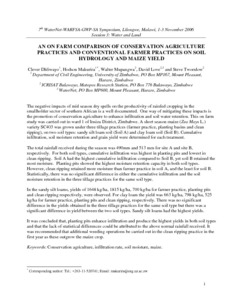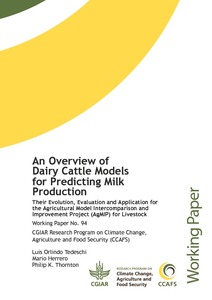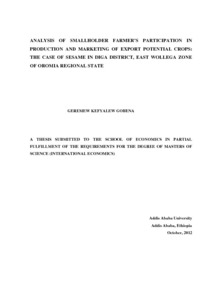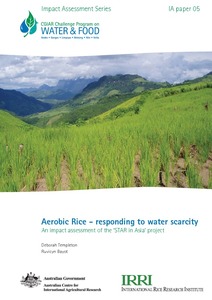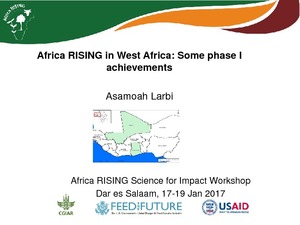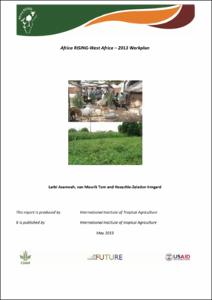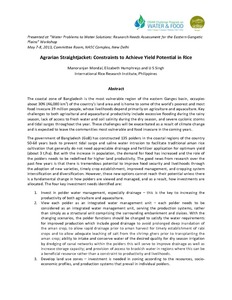Sistemas de explotación
AGROVOC URI:
An Overview of Dairy Cattle Models for Predicting Milk Production: Their Evolution, Evaluation, and Application for the Agricultural Model Intercomparison and Improvement Project (AgMIP) for Livestock.
The contemporary concern about anthropogenic release of greenhouse gas (GHG) into the
environment and the contribution of livestock to this phenomenon have sparked animal
scientists’ interest in predicting methane (CH4) emissions by ruminants. Focusing on milk
production, we address six basic nutrition models or feeding standards (mostly empirical
systems) and five complex nutrition models (mostly mechanistic systems), describe their key
characteristics, and highlight their similarities and differences. Four models were selected to
Análisis económico ex-ante en sistemas de producción asociados: cultivo arroz-pradera
Analysis of smallholder farmer’s participation in production and marketing of export potential crops: The case of sesame in Diga district, east Wollega zone of Oromia Regional State
Agriculture in Ethiopia remains to be the key sector. It is still the main source of foreign exchange earnings (up to 90%) and the largest labour force employer (about 83%). Of the total agricultural output, about 95% was covered by smallholder agriculture sub-sector. However, a number of factors limit smallholder farmers from participating in export potential cash crops. The main objective of this paper is to identify household specific factors determining sesame production and marketing participation.
Animal breeding and productivity studies in Africa
Summarises the work that ILCA is doing to assemble what information is available on livestock breeds and breeding in sub-Saharan Africa.
Aerobic Rice - responding to water scarcity, An impact assessment of the ‘STAR in Asia’ project
Rice, a staple food for over 70% of Asians, is also the single biggest user of water, requiring 2-3 times more input (irrigation plus rain) water per unit of grain produced than crops such as wheat and maize. With growing populations, increased urbanisation and environmental degradation, the supply of fresh water is depleting. Recognising the water constraints to rice yield, the aim of the project entitled ‘Developing a System of Temperate and Tropical Aerobic Rice (STAR) in Asia’ was to develop water-efficient aerobic rice technologies.
Agrarian Straightjacket: Constraints to Achieve Yield Potential in Rice
The coastal zone of Bangladesh is the most vulnerable region of the eastern Ganges basin, occupies about 30% (46,000 km2) of the country’s land area and is home to some of the world’s poorest and most food insecure 39 million people, whose livelihoods depend primarily on agriculture and aquaculture. Key challenges to both agricultural and aquacultural productivity include excessive flooding during the rainy season, lack of access to fresh water and soil salinity during the dry season, and severe cyclonic storms and tidal surges throughout the year.
Agricultural Water Management Technology Expansion and Impact on Crop Yields in Northern Burkina Faso (1980-2010): A Review
Agricultural water management (AWM) interventions, such as soil and water conservation or small-scale irrigation around small-scale water reservoirs, have repeatedly shown benefits to yields, soil fertility and water availability – at the field and experimental farm scale. It is assumed that these benefits will result in better and more sustainable livelihoods. However, there has been little published evidence of such wide-scale beneficial impacts.
A review of mixed farming systems in the semi-arid zone of sub-Saharan Africa
The paper is divided into four chapters. The frist chapter is the introduction. Chapter two discusses the conceptualisation of the farming system with reference to the livestock component and reviews some alternative typologies that have been employed or proposed. A typological framework that is consistent with ILCA's objectives is then outlined. Chapter 3 develops a regionalisation of the semi arid zones of sub-Saharan Africa in four orders of increasing scale. The first order sub-division is between "West and North" and "East and South" geographical regions.


